| March 29, 2018
Still A Brat
The Triumph Speed Triple has been with us since 1994. While it’s gained a touch of respectability, it’s good to see it’s still a British brat at heart.
 Nipped and tucked, the new Speed Triple is a hooligan that’s grown up.
Nipped and tucked, the new Speed Triple is a hooligan that’s grown up.
I remember my first introduction to Triumph’s Speed Triple back in 1994. It was big, it had attitude and it was the first of the true naked roadsters. For that matter, the Speed Triple is pretty much responsible for the whole naked bike market in general. Now, after 24 years of continued success, Triumph is at it again with their new 2018 Speed Triple 1050 S and RS.
Both models intend to set the bar even higher with Triumph pronouncing it “the best Speed Triple Ever.” That’s a bold claim but with a multitude of new design changes and technologies, it might very well be true. Let’s have a go and see how they have done.
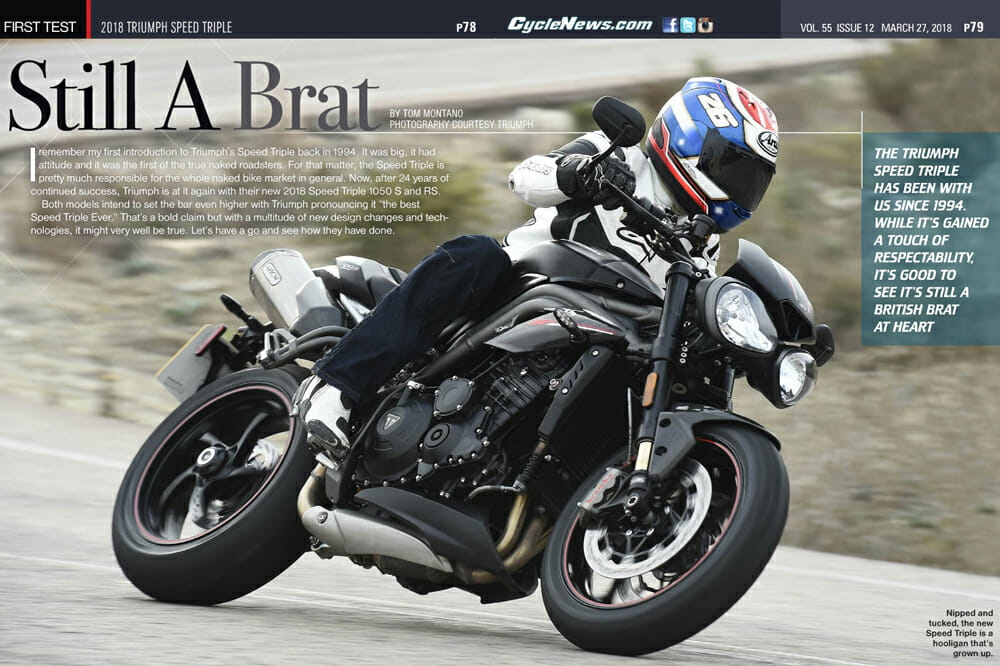
By Tom Montano
Photography Courtesy Triumph
Off To Spain We Go
Our go was to take place in Almeria, Spain, where the weather is always nice, right? Not so fast—this time around we got rained on, big time. Fortunately, we got in plenty of dry miles on the roads, although the track was another story.
When you first set eyes on the new Speed Triple, it looks very similar to its predecessor. Of course, a closer inspection will reveal a new frame, a smaller front cowl, and redesigned headlights. But more importantly and less revealing is the host of motor updates, chassis refinements and the new Ride-by-Wire electronic package.
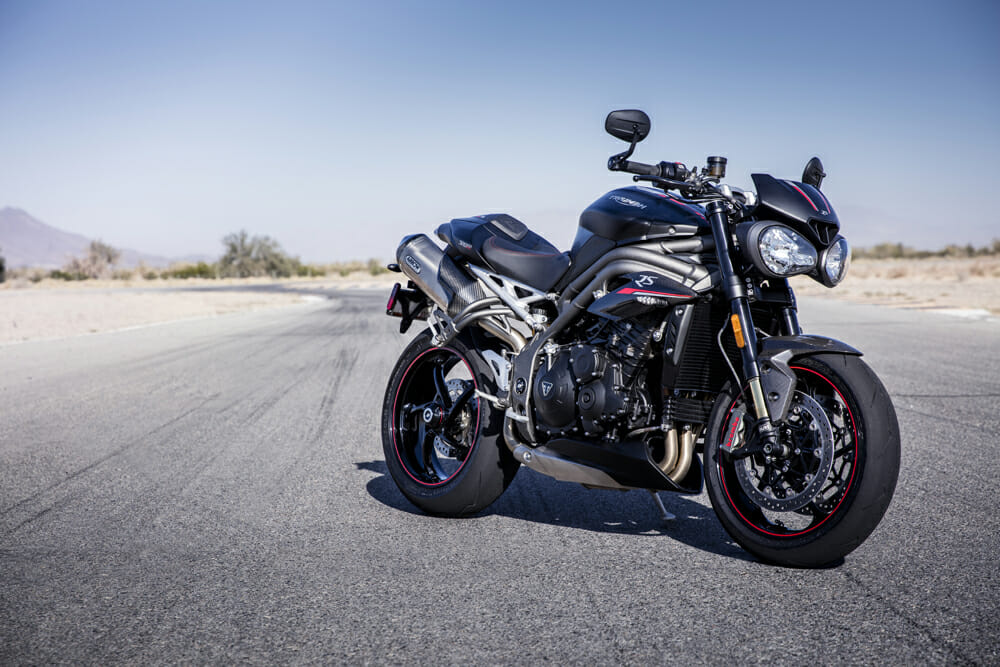 The RS is one hell of a looker with the hardware to match, like premium Ӧhlins and Brembo components.
The RS is one hell of a looker with the hardware to match, like premium Ӧhlins and Brembo components.
First off, let’s talk about the new five-inch TFT adjustable full-color dash that’s borrowed from last year’s 765 Street Triple. This new instrument panel offers three different tach and speedo layouts for the S model, and six for the RS model. Each display features the usual information like water temp, a fuel gauge, gear position, ride mode symbol, clock, total mileage, and so on, but also displays the menu for the new rider modes, ABS and traction control. It’s pretty simple to use with a new five-way joystick toggle on the left handlebar cluster and a home button located on the right cluster.
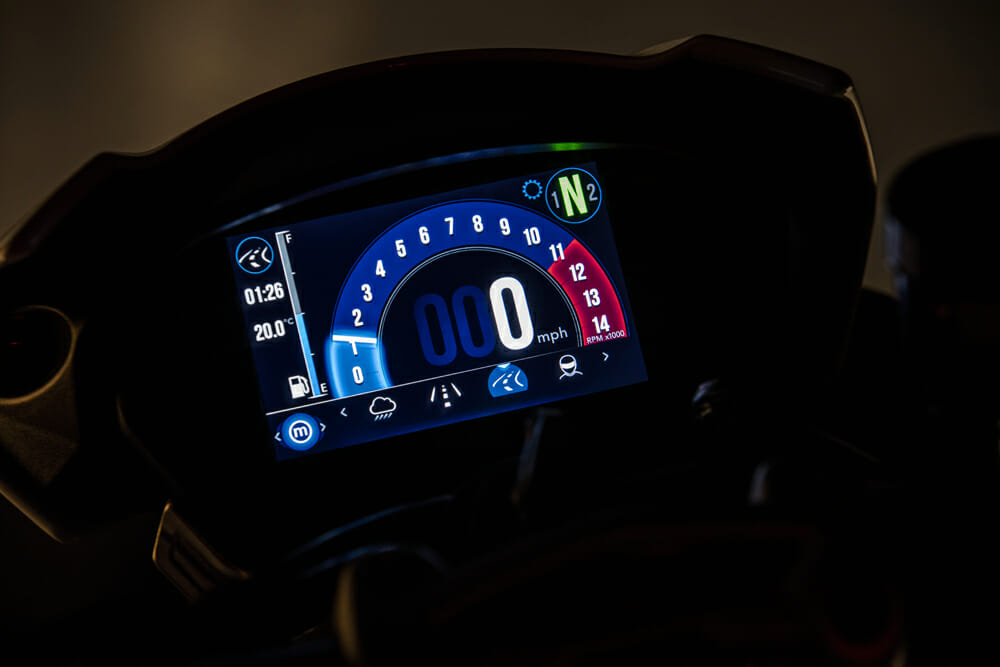 Triumph has one of the best dashes in the business fitted to the Street Triple 765, so it made perfect sense to fit it straight to the Speed Triple.
Triumph has one of the best dashes in the business fitted to the Street Triple 765, so it made perfect sense to fit it straight to the Speed Triple.
By accessing these switches, one can choose and customize the four preset ride modes available on the S model—Street, Road, Rain and Helmet—in other words “Rider Configuration.” The RS features an extra Race mode for max power and throttle response plus more precise traction control and ABS parameters and adjustments, and allows the termination of the ABS braking system.
There is also cruise control and you can even back light all the handlebar cluster controls. A new keyless ignition is now standard on the RS model, which means, with key in pocket, simply walk up to your bike push the start button and off you go. Pretty cool, but at a gas stop you have to produce the key to open the gas tank—not too sure about that, as I much prefer pulling the key from the ignition—but then again, I’m old school.
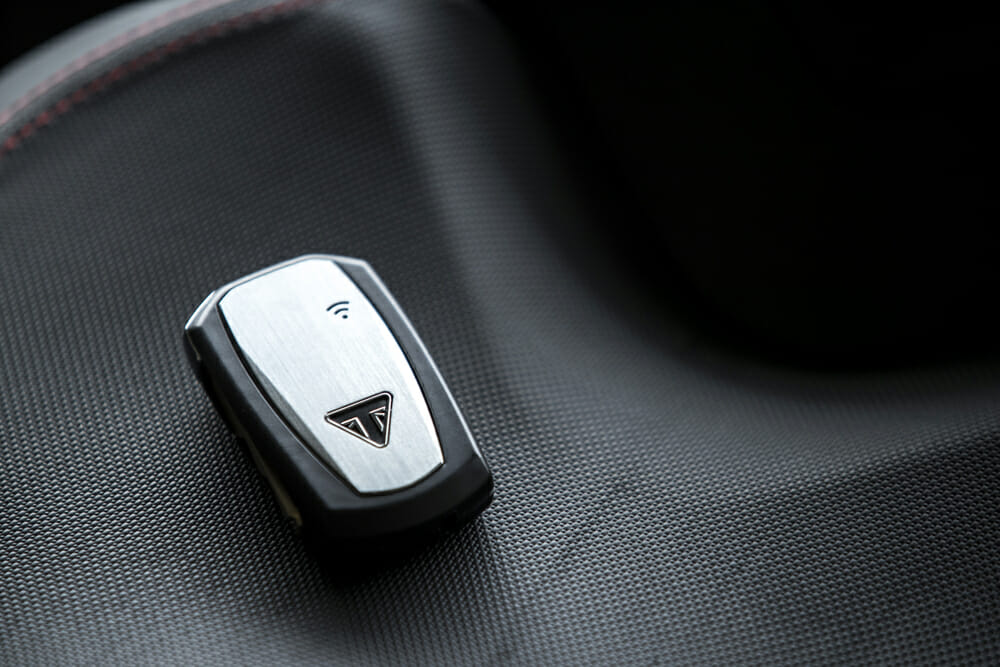 Keyless ignition is here to stay with the Triumph range, for better or for worse.
Keyless ignition is here to stay with the Triumph range, for better or for worse.
You Want Torque?
We started out on new 1050 RS Speed Triples—no S model for this intro. After a few side streets, we hit the motorway. Cruising along at highway speed in Sport or Road modes, the revs anywhere from 5000 to 6000 rpm was supreme—no hesitation or uneven throttle response, just a nice smooth and positive delivery. When approaching a slower vehicle just grab a hand full and be done with it. With 86 lb-ft of torque available, (four percent more than the previous Speed Triple), the pick-up is instant. One of the points of interest is the deeper, throatier exhaust pitch—like eye fillet cooked by a Michelin-star chef for the ears. The RS is fitted with newly homologated Arrow exhaust, while the S also has new, redesigned mufflers but of a standard type. You wonder how they got away with aftermarket exhaust? Simple: by lowering the amount of noise emulating from the motor, Triumph could add noise elsewhere—very cool.
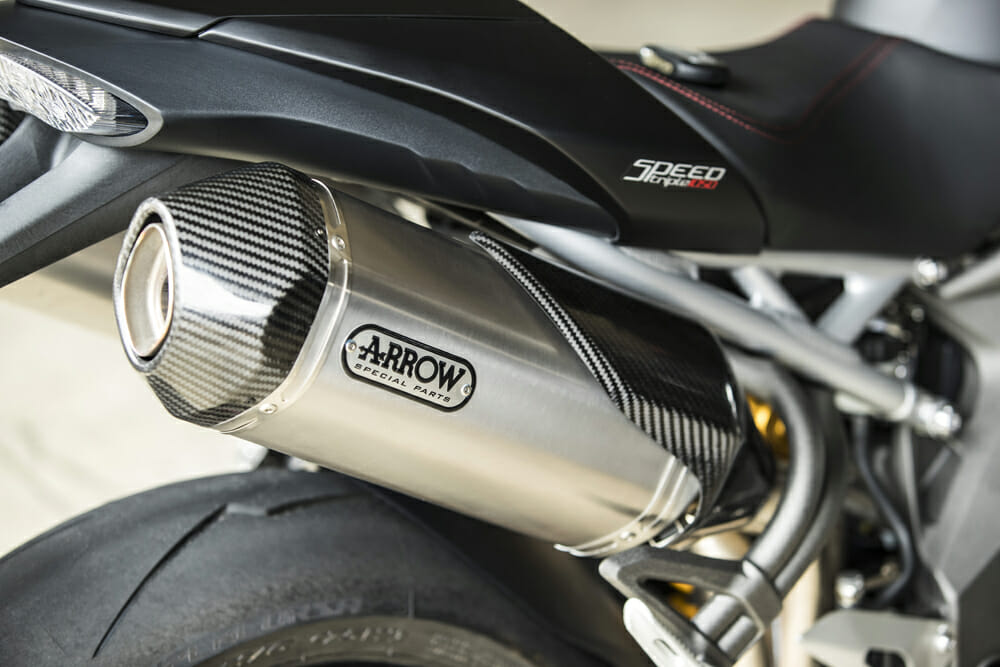 Unbelievably (and thankfully), these Arrow mufflers are street legal!
Unbelievably (and thankfully), these Arrow mufflers are street legal!
As far as the chassis the goes, the Speed Triple RS model comes with new Ӧhlins 43mm NIX 30 forks and an Ӧhlins TTX36 rear shock, while the S model receives Showa units front and rear. Both the S and RS’s suspension are fully adjustable, as you’d expect. On the freeway, the suspension was very compliant. You will find it has the right amount of forgiveness for the more challenging surfaces, i.e. bumps and potholes, but retains enough stiffness to keep it steady and comfortable at speed.
By the time we hit the back roads I had become spoiled with Triumph’s new electronic shifting function, which is unique to the RS, providing easy clutchless up and down shifts. Some important revisions within the transmission and a revised slipper clutch have also helped smooth out gear shifting.
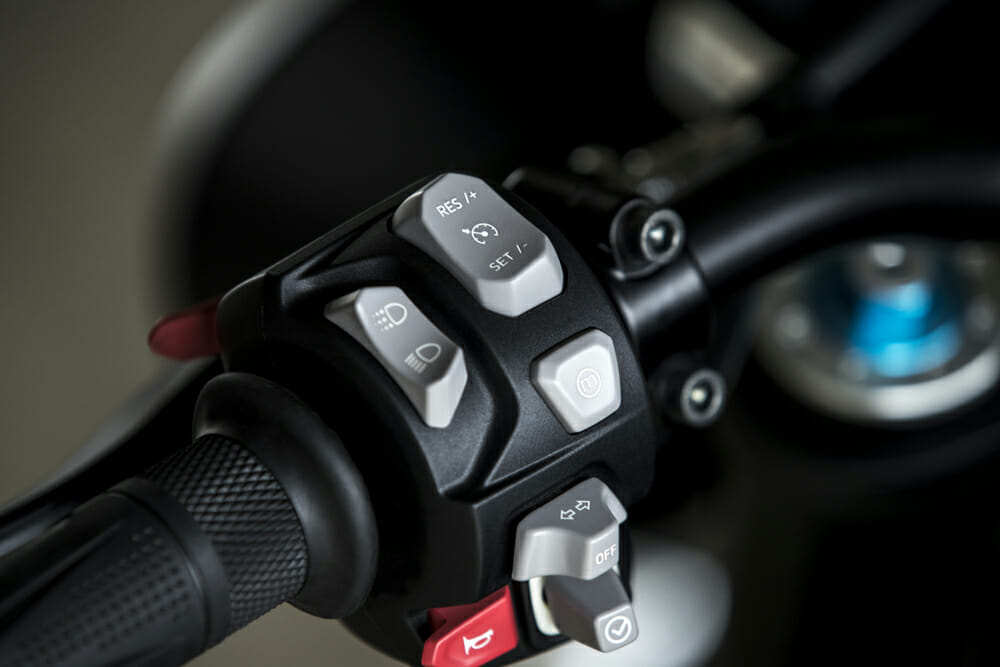 Cruise control is a standard feature on the Speed Triple.
Cruise control is a standard feature on the Speed Triple.
From the very first set of corners onward, the new 1050 RS is quite comfortable. The seating position is a bit more forward leaning and aggressive than the previous model, which is nice for sport riding. At 5’ 9”, I was able to navigate the controls very well plus I could reach the ground at stops with ease.
The Speed Triple is not the sharpest bike in terms of precise handling but there’s plenty of feel to throw it around with confidence. It’s surprising how well you can bury the bike into the corners. The classic inch-high handlebars are essential for aggressive cornering by providing plenty of leverage when needed. On exits, the Speed Triple performs equally as well, driving hard out the corners with minimal movement from the rear suspension. Even through very fast sweepers, the 1050 RS kept its line and felt every bit as composed your average sport bike. Braking-wise, the dual Brembo M4.34 radial monobloc four-piston calipers, controlled by a new Brembo master cylinder featuring an MCS span and ratio adjustable brake lever, provide more than enough braking capability to get the job done. A new pad material, combined with the Brembo 320mm rotors, offers plenty of bite and feel at every level of engagement. The brakes work great and the chassis is capable enough to handle even the most extreme braking situations without losing its composure.
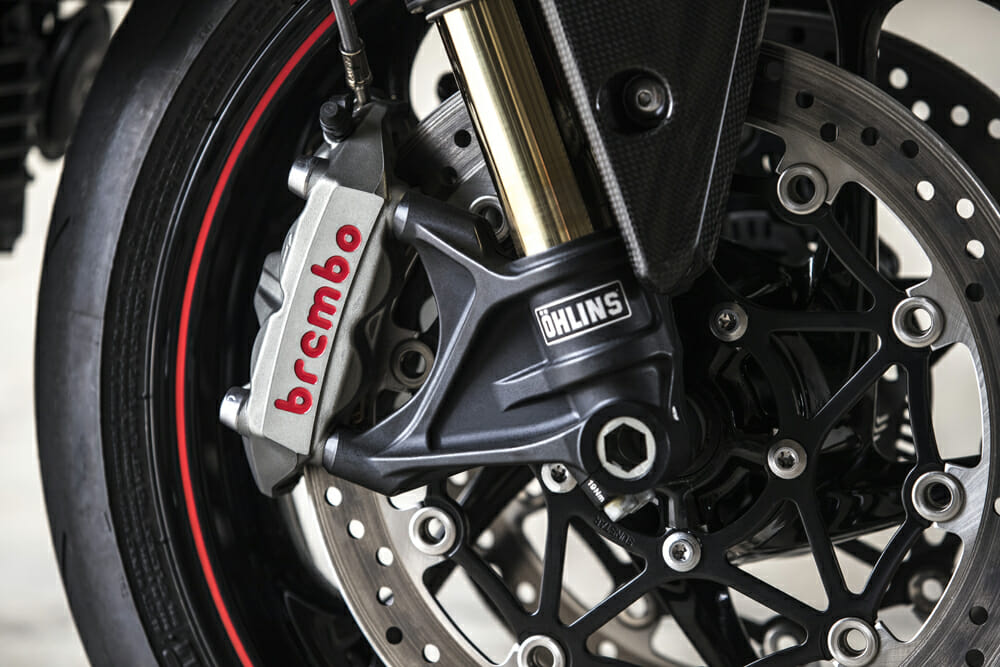 Both models get these beautiful Brembo monobloc calipers as standard.
Both models get these beautiful Brembo monobloc calipers as standard.
The new Speed Triple 1050 RS also features Triumph’s latest cornering ABS and traction control, which is supported by a new Continental IMU (Inertial Measurement Unit). The system is very well calibrated to limit the amount of interference, except in critical moments. Even then you rarely notice the ABS system working.
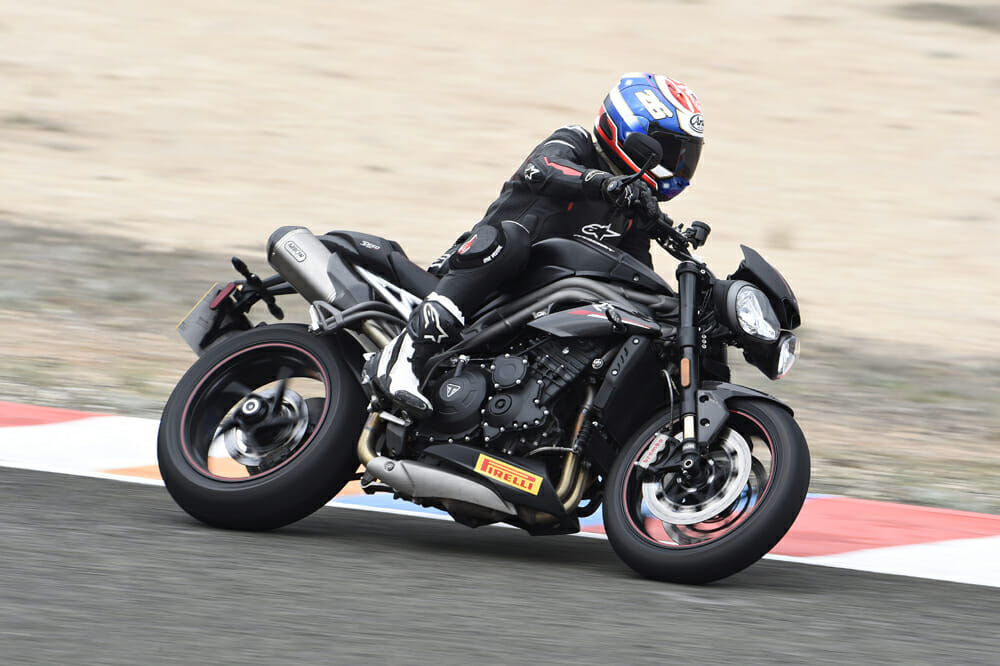 Even though it wasn’t designed as such, the Speed Triple makes for a handy trackday tool.
Even though it wasn’t designed as such, the Speed Triple makes for a handy trackday tool.
Pick Your Poison
On several occasions throughout the ride, I scrolled though the different riding modes to see how they felt. The overall power output is the same—148 horsepower at 10,500 rpm, up seven percent over the previous model. What is different is how you get there. Each ride mode has a different throttle response. Race mode hits the hardest and is the quickest revving. In Street or Road modes the throttle is a bit tamer, with less of a hit and a slightly slower pick-up, but you still get up to the full 148 horses. The Rider Configuration mode can be arranged however you want while the Rain mode cuts power to 100 horsepower and has the most ABS and traction control engagement of the lot.
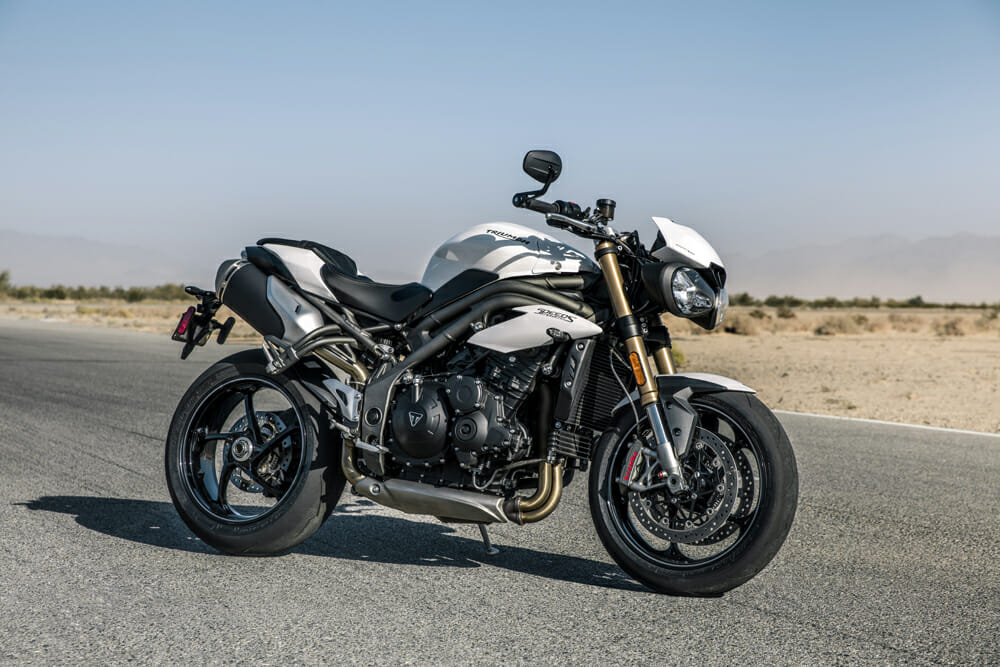 The S model in all its glory. No Ohlins suspension, but still a heck of a bike.
The S model in all its glory. No Ohlins suspension, but still a heck of a bike.
When we did hit the weather, I switched to Rain mode. Straight away I noticed how much slower and almost dull feeling the throttle response was, but that’s a good thing. Our track time was wet so Rain mode was, once again, the right choice.
On the wet track, the 1050 performed well, no real issues. There’s still enough pick-up in Rain mode to scare yourself but it’s nice to know with the added ABS and traction control you’ll have to put in some serious effort to throw it down the road.
The 2018 Speed Triple is a worthy addition to the saga that started back in 1994. It’s now somewhat grown up, with the top-line engine, chassis and electronic components. It’s easy to see why this bike is regarded as the savior for modern day Triumph—it kick-started an entirely new segment of motorcycling—and set the company right after so many years in the red.
But it’s still a British brat, still that naughty little bike we fell in love with all those years ago, and that’s a very good thing, indeed.
Into The Skin
Triumph put a lot of work into the new 1050 Speed Triple. With 105 new parts in the engine alone, Triumph has produced their lightest, most powerful Speed Triple to date. The new triple-cylinder engine features a lighter crank gear, lighter Nikasil aluminum cylinder liners, lighter balance shaft, a smaller starter motor and a lighter alternator. A new cylinder-head design with better porting and newly reshaped pistons has raised the compression ratio from 12.25:1 to 12.92:1. The bore and stroke is now at 79 x 71.4mm. They have also redesigned the oil pick-up sump for less crank drag and re-routed the oil system, which now flows internally through the motor, removing the external pipes which equals less weight and improved looks.
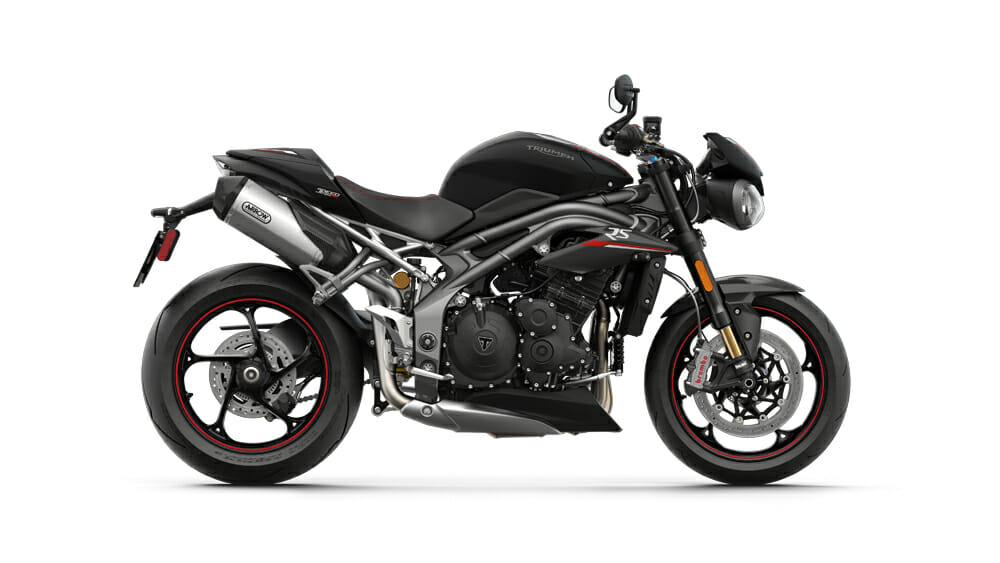 Subtle but numerous changes distinguish the ’18 Speed Triple from the ’17.
Subtle but numerous changes distinguish the ’18 Speed Triple from the ’17.
What you get is a faster and higher-revving three-cylinder powerplant with a new redline at 10,500 rpm, 1000 rpm higher than the previous Speed Triple. Throw in a new chassis and more advanced electronics and you’ve brought the Speed Triple into the modern era. You can find the new 1050 Speed Triple in two distinct colors. The S model comes in a Jet Black or Crystal White paint scheme with a titanium-colored rear subframe. The RS comes in a Crystal White or Matte Jet Black color with an aluminum subframe. Both models are fitted with Pirelli’s latest Diablo Supercorsa tires. You get a lot of bike in the new 1050 Speed Triple considering it’s a stripped-down hooligan special but that’s what you want—something that looks the part but does the business even better.
A Quick History Lesson
Over the years, Triumph has endured several changes and hardships but it has become one of the most iconic brands in motorcycling. Of course, the test of time took its toll and Triumph called it quits by the end of the seventies after having started production in 1902. But with a name like Triumph, steeped in motorcycle history, chances are it wouldn’t be gone forever. Sure enough, in 1983, a gentleman named John Bloor came to the rescue and purchased the company and put Triumph back in the game. It took some doing but by 1990 Triumph had developed two new three- and four-cylinder motors to power a new fleet of Triumph motorcycles. Finally, in 1991, the first unit rolled off the line.
At first, the bikes were a bit dodgy, as the products they were producing were big and bulky and performance was not at the level of the already well-established European and Japanese brands. Over the years, though, Triumph managed to get a handle on what works and what doesn’t. It’s taken them a while but now they are a major player in the modern motorcycle industry.
Having secured a spot in one of the world’s premier motorcycle racing classes as sole supplier for Moto2 engines from 2019 onwards speaks volumes of the success of the company. That’s a great achievement for the relatively small brand out of Hinckley in the UK. John Bloor not only rebooted the Triumph brand but is the responsible party behind the inception of the triple engine design. As we all know now, the three-cylinder powerplant has become the heart and soul of the new Triumph motorcycle company. And the triple’s place is in the Speed Triple.
 Second time around with the T509, the Speed Triple started to come into its own.
Second time around with the T509, the Speed Triple started to come into its own.
In 1994, Triumph launched the T309 Speed Triple calling it “The Original Hooligan,” and since then has grown in popularity across the globe. The Speed Triple has seen several different models spanning a 24-year period of evolution, culminating in the introduction of the new-for-2018 Speed Triple 1050 S, and RS.
In 1997, Triumph produced the T509, which was their second attempt at the Speed Triple. This time around it featured the now classic double tube cast aluminum frame design and single-sided swingarm, which surprisingly enough, has been part of the Speed Triple DNA ever since. 1999 saw the next generation of Speed Triple in the forum of the 955i, which, by the way, was my first real introduction to the model. By then the whole naked-bike market was well established which, of course, was Triumph’s doing.
The Speed Triple was really beginning to gain some respect among the motorcycling community and 2005 brought us yet another version of the big triple, which featured a new 1050cc motor. 2011 saw the next coming of the 1050 Speed Triple with the new design and styling, which are still present in today’s version. I was fortunate enough to ride that model in Spain at the press launch—that bike was quite impressive and on the right track to becoming a serious contender in the, by then, well-attended naked bike category. Finally, we are at the 2018 1050 Speed Triple S and RS, which are by far their best Speed Triples to date. CN
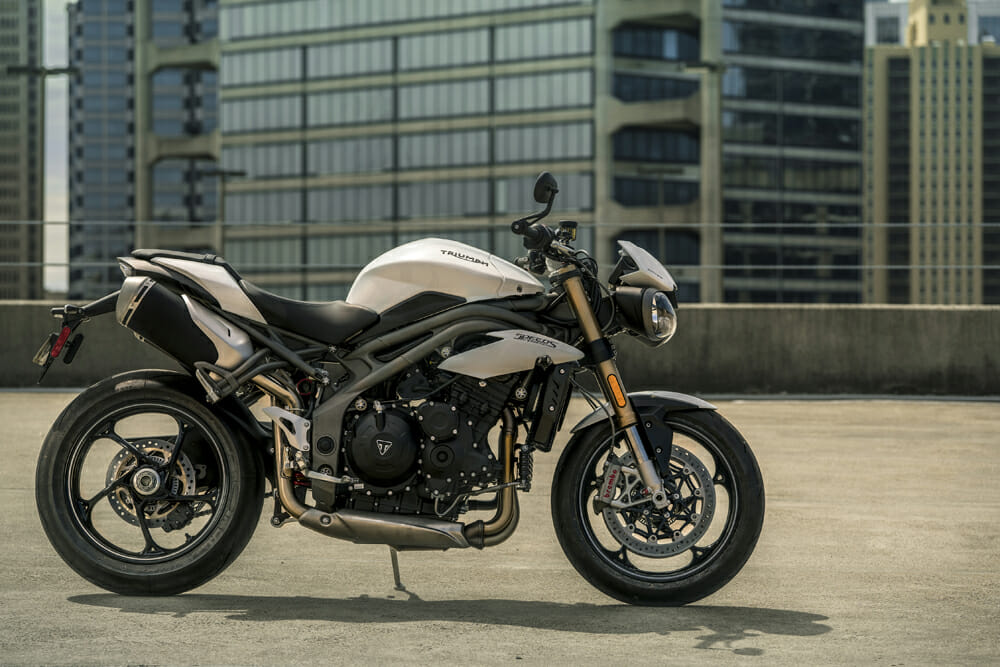
|
SPECIFICATIONS
|
|
|
2018 Triumph Speed Triple 1050 S ($14,350) / RS ($16,350)
|
|
Engine:
|
Liquid-cooled, 12 valve, DOHC, inline 3-cylinder
|
|
Displacement:
|
1050cc
|
|
Bore x stroke:
|
79 x 71.4mm
|
|
Compression ratio:
|
12.92:1
|
|
Power:
|
148 hp @ 10,500 rpm
|
|
Torque:
|
86 lb-ft @ 7150 rpm
|
|
Clutch:
|
Wet multi-plate, assist and slipper type
|
|
Transmission:
|
6-speed
|
|
Chassis:
|
Aluminum beam twin-spar
|
|
Front suspension:
|
Showa 43 mm upside-down forks with adjustable preload, rebound and compression damping / Ӧhlins 43mm NIX30
|
|
Rear suspension:
|
Showa monoshock with adjustable preload, rebound and compression damping / Ӧhlins TTX36 shock
|
|
Front wheel travel:
|
4.7 in.
|
|
Rear wheel travel:
|
5.1 in.
|
|
Front brake:
|
Dual 320mm floating discs, Brembo 4-piston monobloc radial calipers, switchable ABS
|
|
Rear brake:
|
255mm disc, 2-piston sliding caliper, switchable ABS
|
|
Front tire:
|
120/70 ZR17
|
|
Rear tire:
|
190/55 ZR17
|
|
Wheelbase:
|
56.89 in.
|
|
Seat height:
|
32.48 in.
|
|
Fuel capacity:
|
4.1 gal.
|
|
Weight (dry, claimed):
|
423 lbs.
|
|
Color:
|
Crystal White, Jet Black / Crystal White, Matte Jet Black
|